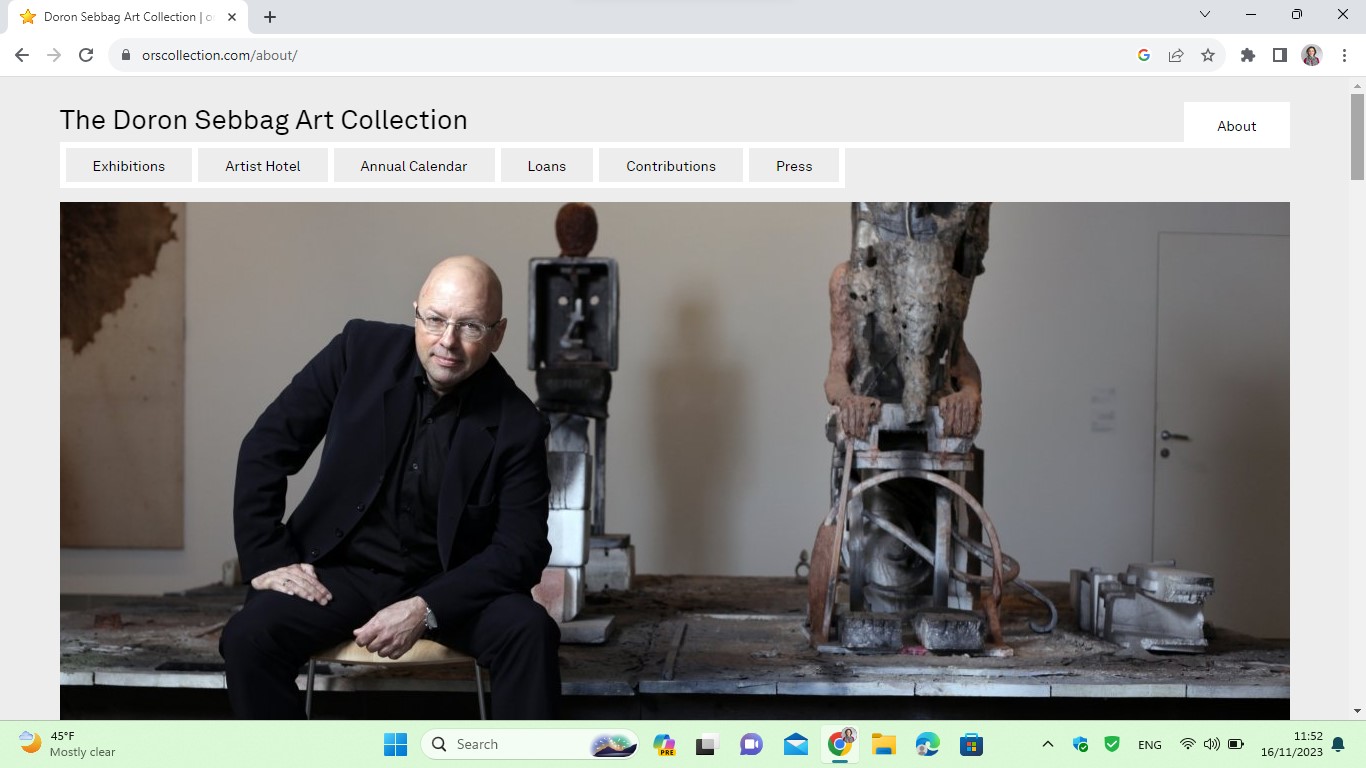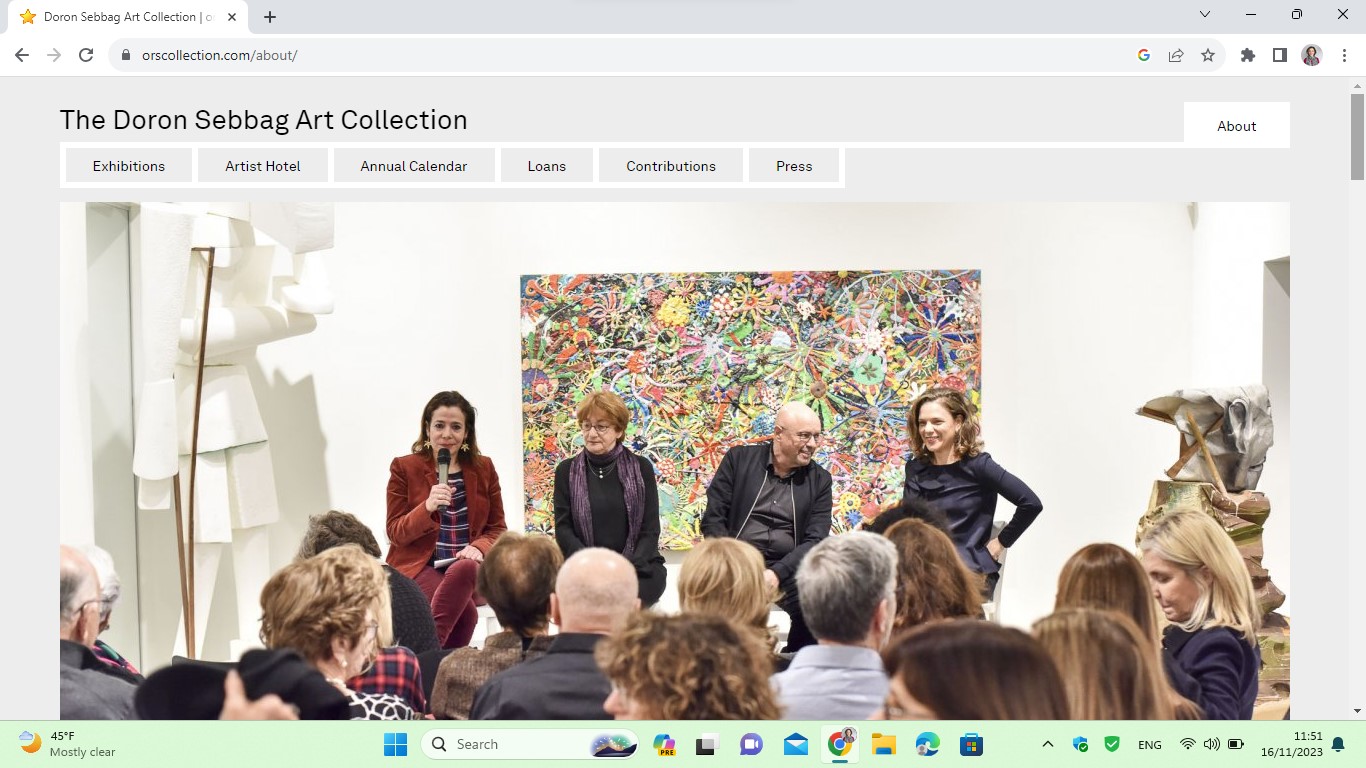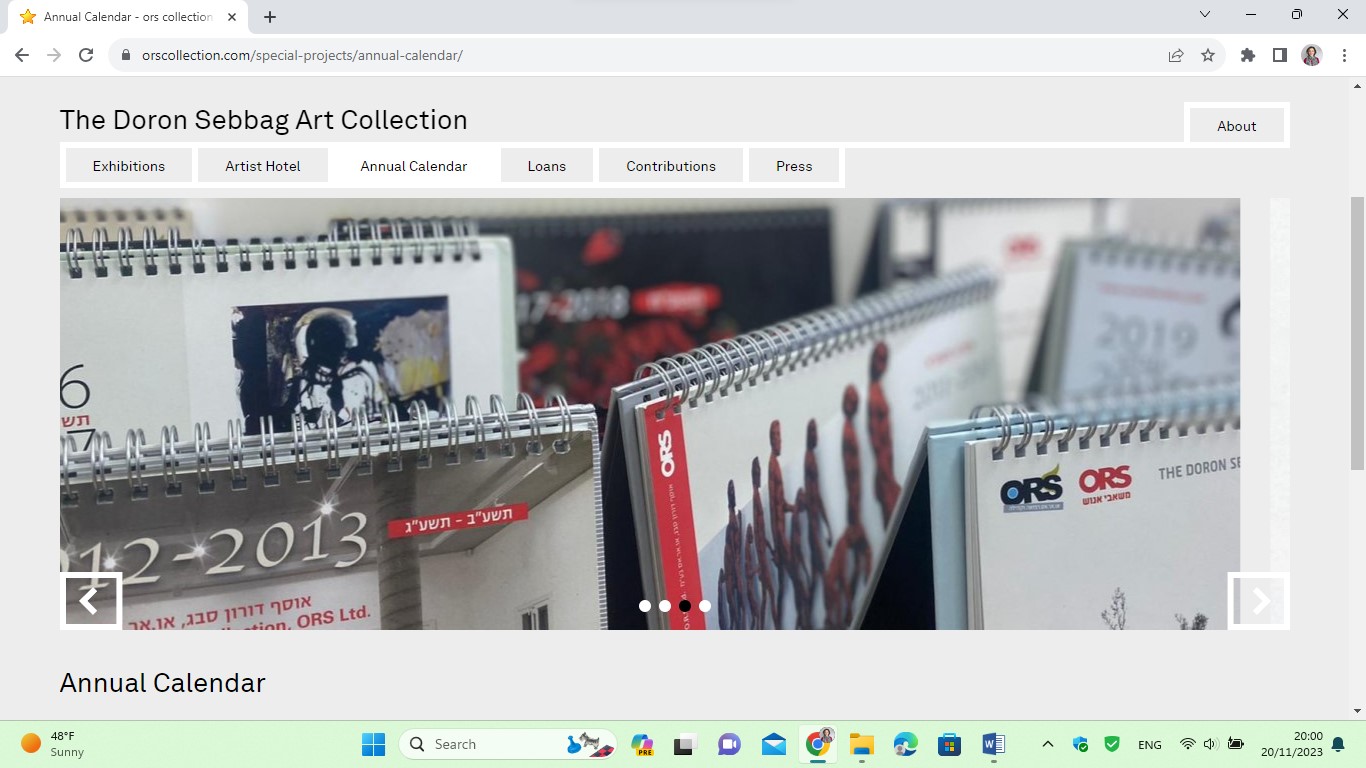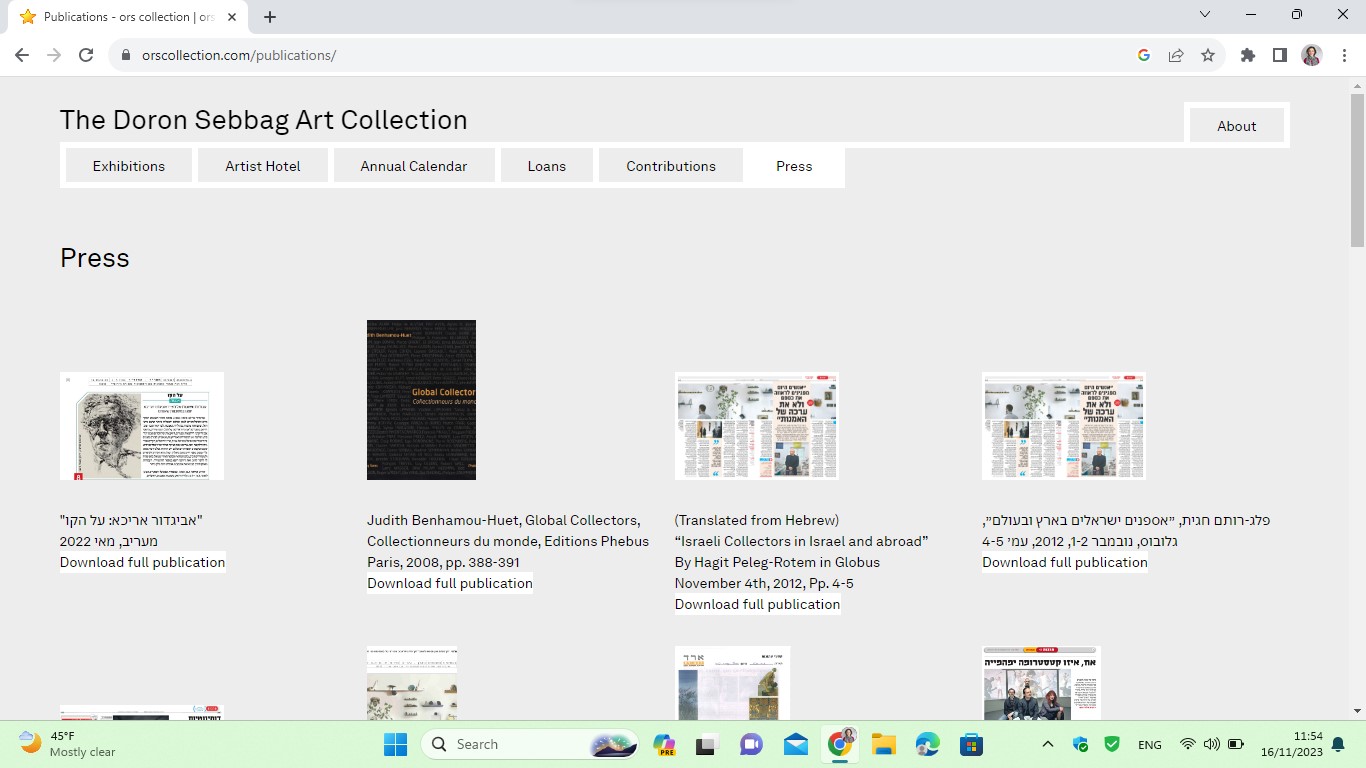
The Doron Sebbag Art Collection was established in Tel Aviv at the beginning of the 1990s by Doron Sebbag, a passionate art connoisseur. It comprises over 1,200 Israeli and international contemporary artworks in assorted media. The original statement of the Collection declared by the first collection’s curator, Dr. Aya Lurie was: “The two major values that have guided Sebbag as a collector throughout the years are the decision to purchase and present contemporary Israeli and international art side by side, and the decision to expose the collection to the public through exhibitions.” (Lurie, Aya. 2000. “Forward.” In Exposure: recent acquisitions from the Doron Sebbag Art Collection. 5-6. Tel Aviv: Tel Aviv Museum of Art.) This paper aims to analyze the Collection’s website, its role at its foundation in 2013, concerning the period’s characteristics and the Collection’s activities. Moreover, it will explore what could have been done differently if the website were to be created today, a decade later.
During these almost three decades of extensive activity, works from the Collection were on loan to museums in Israel and abroad, and diverse theme exhibitions have been staged, some in public museums or institutions, and some in private spaces. The Collection has never had a permanent physical exhibition space, and over the years, its staff has remained small, ranging from one person responsible for curating, and day-to-day operations, to up to four individuals during special events. For many years, the artworks have been accessible to the public only during exhibitions periods or through loans. During the last decade, the Collection’s activities were broadened and various initiatives took place, consisting of collaborations with different institutions, some private, and some cultural and educational. For example, one of the main projects from the Collection was a collaboration with local artists at a private boutique hotel in Tel Aviv (ARTIST Hotel), owned by the collector. As part of the hotel renovation, the chosen artists produced a site-specific art piece for the hotel rooms and corridors. (Atlas Hotels. Artist Hotel, Tel Aviv. Accessed November 4th, 2023. https://www.atlas.co.il/artist-hotel-tel-aviv.)
Private Art Collections in Israel
To gain a comprehensive understanding of the Collection’s historical context from a decade ago, I would like to incorporate insights from the Israeli art scene, with a particular focus on the art market, private collectors, and their impact. In her research “Bringing Collectors of Israeli Art from the Dark” (2022), Milly Perry analyzes the phenomenon of collecting Israeli art in Israel and notes that the Israeli art market is small and limited, managed by a small group of influential collectors in Israel, including Doron Sebbag, several leading gallery owners, museum directors and curators of Israeli art and an auction house. The extent and nature of their influence and interrelations change in correlation with the period and the composition of the community active in the field at the time. Her study thus supports the conclusion that the collectors’ role and standing are important and influential concerning how art history is created in Israel and that in certain cases, they even shape the future of the art ecosystem and the art market in Israel. In addition, she focuses on the processes of globalization in the art world and the integration of Israeli artists into the global art world, as the ties between galleries and collectors. (Perry, Milly. 2023. Bringing Collectors of Israeli Art from the Dark. Tel Aviv: Tel Aviv University Press. Original in Hebrew.)
Establishing a new collection website
As both the manager and the Collection’s curator from 2008 to 2023 (started as the assistant curator to curator Dr. Aya Lurie until the year 2010), I held responsibility for the online presence of the Collection, which was established in 2013. The need for a website derived from the willingness of the collector, Mr. Sebbag, to expose the vast activities, and to brand the collection.
When establishing a website for a private art collection, numerous factors had to be carefully considered, primarily revolving around the balance between the collector’s desire to expose the Collection’s activities without sharing the artworks as open access. I needed to respect the collector’s wish for discretion. The Collection is private and, unlike the museum’s public collections, there was no obligation to operate like a public museum. Therefore, the artwork’s database was documented in a separate cloud-based collection management software, used for our internal use, with the option to access only with a password.
The work on the website lasted about a year and a half. My research during this period encompassed various aspects, starting from the archival research, until the final design. The inspiration for creating the online web stemmed from research into private art collections and museum websites and professional reviews of these times. My research, conducted in collaboration with my assistant Donna Polack, primarily delved into the historical materials and archives of the collection, encompassing various aspects such as support history, loans, publications, and exhibitions. I started to work on the online website after the end of a critical point, when an exhibition I co-curated with curator Tal Yahas was held outside of a museum, in a private art institution, for the first time. (Golan Miller, Dana. A Collection’s Evolution. “Accelerating Toward Apocalypse: Works from the Doron Sebbag Art Collection, ORS Ltd.” Tel Aviv: Givon Art Forum, 1909) I had written a text for the exhibition catalog that could serve as a foundation for the creation of a website, with a focus on highlighting the collection’s activities and its innovative approach:
The collection expresses Sebbag’s attempt to comprehend, identify, and decode - from a large selection of contemporary artworks - those that reflect the zeitgeist and the constantly evolving culture. Hence, the collection functions as an active organism in a never-ending process of becoming; it is an infinite pursuit of an object of desire by someone who enjoys the search and research, who vigorously follows new, dynamic approaches in art, trying to pinpoint, in advance, the cultural heroes of the future. The exhibition enables examination of the metamorphoses of the collection as a life’s work, a type of time travel into the depths of the evolving contemporary culture, on which Sebbag takes us, against the backdrop of an atmosphere of apocalypse, as if he were asking himself what he has formed thus far, but also - what is the essence that he takes with him, into the future.(Golan Miller, Dana. A Collection’s Evolution. “Accelerating Toward Apocalypse: Works from the Doron Sebbag Art Collection, ORS Ltd.” Tel Aviv: Givon Art Forum, 1909)
After mentioning the art scene atmosphere in Israel and the Collection’s activity, it can be seen that during this period, the primary aim was to focus on Doron Sebbag as a collector, the Collection’s accomplishments, and to emphasize the vast activities. In other words: create a ‘business card’ for the collection and brand it. The purpose was to engage with researchers in Israel, as well as abroad, curators, and art collectors. This process involved assessing how much the collector aimed to establish connections or affiliations with the local artistic canon versus his aspiration to be part of the global private art collections. Using the English language was part of the aim of trying to show that we are In Israel, but we also have a global orientation (figures 1 and 2).

Our main resources at that point were other international websites of private art collections that served as our inspiration. We looked especially at the UBS art collection, A New York established bank, that has a vast contemporary art collection, and at that time, was very impressive without having a space for itself, as in our case. (UBS contemporary art. “UBS Art Collection.” Accessed November 4th, 2023. https://www.ubs.com/global/en/our-firm/art/art-collection.html) We also looked at websites of small museums as an inspiration. In their research, Creating Brand Identity in Art Museums: A Case Study (2014, 18-20) Sofia Beanding Pusa and Liisa Uusitalo noted that:
In the current non-elitist culture, a renowned consequently, to differentiate themselves from the competition and to attract non-expert audiences, art museums have to pay more attention to creating a strong brand. Museum brand is becoming a sign of a quality museum’s distinctiveness and attractiveness… with a strong brand identity, art museums can improve their ability to promote exhibitions and perform other tasks connected to their integral core elements and long-term objectives… In smaller organizations, in particular, the museum’s manager, curator, or founder can project their own personal characteristics and artistic taste onto the museum. In addition to direct use value, the non-use benefits are many, especially the museum’s role in heritage transfer to future generations, and in advancing the stock of intellectual capital - important for art and design industries… Technology can be exploited in relationship marketing and interactions with customers… Network associations abroad, experimental relationships with, and direct marketing to, consumers, together with new, creative promotion schemes such as showing collections online, are considered better ways to assert identity. (Beanding Pusa, Sofia and Uusitalo, Liisa. 2014. “Creating Brand Identity in Art Museums: A Case Study.” International Journal of Arts Management 17, no. 1: 21-23.)
Their research was fit for the period we worked on the website.
Mapping the website design and appearance
To align with that purpose brand, and to connect with researchers, art collectors, and professionals, I decided to focus on the important activities of the Collection. I divided the navigated field choices on the website into exhibitions, donations, works that were in loans, and the special project - a yearly Hebrew calendar that includes the Collection’s work (fig. 3). In the field about I wrote about Doron Sebbag and the Collection (fig. 4). Instead of including the images of the artworks, I listed the names of the artists in alphabetic order. Also, I added another field - press, where we inserted scanned articles from the press about the collection (fig. 5). We used WordPress, and most of the documents were inserted in PDF formats after professional scanning.



When we launched the website at the end of 2013, I felt a sense of satisfaction. It may have been different from the websites of the world’s largest private art collectors, but it served as an excellent platform to showcase our identity, introduce Doron Sebbag, and highlight our achievements in the art scene. These navigation fields still exist today.
2013 - 2023 – website updates
A lot happened throughout that period, concerning private art collecting. One of the recent searches of art collectors conducted by Fabio Rojas & Peter Lista (2022) defined that collecting reflects personal identities and the collector’s position in a globalized art world. This study “focuses on the collector’s trajectory through the art world and the overlapping pulls of status and community. As the art world expands through the proliferation of art fairs, social media, and online art sales portals, it will be important to understand the lives of collectors as individuals moving through a social world and not just as provider of capital.” (Rojas, Fabio, and Peter Lista. 2022. A Sociological Theory of Contemporary Art Collectors. The Journal of Arts Management, Law, and Society 52 (2): 88-100.)
During that decade, I fulfilled many daily operations roles in the Collection and had no time to update the website. This is sometimes the case with small museums. Luna Leoni and Matteo Cristofaro claim (2022), that sometimes small museums are afraid of adopting new technologies mainly because of the risks and investments in terms of time, and human and financial resources. But, they also claim that the most used technologies by small museums are the website, online presence on non-proprietary channels, and social media; and that public and private small museums have an equal level of technology adoption. (Leoni, Luna, and Cristofaro Matteo. 2021. “To Adopt or Not to Adopt? A Co-Evolutionary Framework and Paradox of Technology Adoption by Small Museums.” Current Issues in Tourism 2969-2990 (25:18): 1-22. https://doi.org/10.1080/13683500.2020.1870941.)
As for the website, during this decade, I kept updating the basic information: for each exhibition, I provided the same materials - JPEG images, text, and a PDF version of the new catalog we produced for each exhibition (we used WordPress and kept it). I added very few ideas that were more accessible, such as a virtual tour of the Artist Hotel, and a Hebrew text about Doron Sebbag. In addition, for the latest exhibition, if we come closer to the year 2022, I added audio files to express the exhibition idea. But still, the appearance stayed the same as in the Year 2013.
Thinking about how to engage, how to better access.
In his ‘Oral History of Museum Computing’ Paul Marty discusses his own story related to the changes in technology and their influence on the works of the staff. In the end, he summarizes that:
To wrap up our entire history of technology in museums, the technology changes so much faster than society does, and how do we keep our norms, our ethics, our laws, our legal practices moving along with our technology and how hard that is. But it speaks again to the value of technology and museums for effecting change in the world, for building broader communities online, and in person, building empathy, and emphasizing our shared humanity. My argument always has been that the more we can do to do broader outreach, to get museums to present their information to our broader community, the better off we’re going to be in general. (Marty, Paul. 2021. Oral History of Museum Computing. youtube.com. Creative Commons Attribution 4.0 International license (CC-BY). June 18, 2021. https://www.youtube.com/watch?v=O2kqFu0nyK4)
If I were to embark on recreating a new online website and digitalization setup today, I would reflect on the sources of my inspiration and explore more innovative approaches for accessing the Collection. How might I emphasize the vast activities of three decades and stay updated? Additionally, how can I promote connectivity, foster dialogue, and reorient it toward engagement on many levels? Since the Collection is not an open-source access database, how can I find a creative solution to expose some of the works?
When looking at some websites of private contemporary art collections for inspiration, there are three in mind. One of the examples can be shown in the Broad Foundation. (The Broad. “The Broad Digital.” Accessed November 4th, 2023. https://www.thebroad.org/digital)
Allison Schoen mentioned the Broad Private Foundation as a good example of “providing education and access to contemporary art for students.” She also noted that “Founders of contemporary private museums possess the influence and opportunity to create new models of museum experiences further. While each museum carries out its mission differently, each of the founders creates a positive impact on their community.” (Schoen, Allison. 2022. Private Collection, Personal Utopia: An Examination of Trends in Contemporary Private Museums in the United States. Dissertation, the George Washington University.)
With that in mind, I will list some ideas, to align with the purpose that I think should be the most important - how to access, engage, and present the art Collection in a new way, and show its history in a new light. Of course, more budget or stuff is needed to operate it. But it can definitely be produced with the right programming and a defined time slot.
Interactive ideas
-
As for the Collection activities: Exhibitions can be shown in a much more appealing and interactive appearance. Loans should provide links to the institutions.
-
Find different ways to update the press/media materials, and of course, add the latest and access them with digital innovation, such as video and audio. For example, adding the audio for the last article written about the collection in Jerusalem Post. (Lenkinski, Ori J. 2022. “The Doron Sebbag Collection to Bring Art Where It Doesn’t Strive.” The Jerusalem Post. December 21, 2022. https://www.jpost.com/israel-news/culture/article-725405.) Furthermore, concerning publication - Adding YouTube files of documented conferences, that we took part in, and lectures. For example: the last one that was held was in Jerusalem at the big auditorium of Mishkent Shaananim with scholars (2021). (Opening of the Exhibition between the Line - Avigdor Arikha. 2022. youtube.com. Mishkenot Shananim Jerusalem Channel. May 16, 2022. 50:18 minutes. https://youtu.be/OXszpSzbofU?si=-HtLDSld0cta3KdV.)
A good example of inspiration can be found in the interactive and designed media section, on the Zabloduwicz art collection website – a private art space in London, owned by the collectors Anita and Poju Zabludowicz. (Zabludowicz collection. “Media.” Accessed November 4th, 2023 https://www.zabludowiczcollection.com/media)
-
Adding social media activities, which connect directly with the website content. There is a Facebook page for the collection, but it’s not active.
-
Educational activities. We have done some, and so far I have been involved in two of them, which I initiated and promoted. There is a minimum appearance on the website. This should be one of the main navigation fields.
-
Videos and Podcasts: produce a series of conversations between artists from the collection, former curators of the collection’s exhibition, and so on. Each reflects the year that the work was purchased or the exhibition produced with adding discussion such as ‘then and now’. The Collection archive includes two filming interviews with Sebbag, which were held by a media reporter. One way to show them is by having a new interview today with Sebbag, relating and reacting to them, with new comments about the market then, compared to now. In that way, the observer can learn about the collections from nowadays but relate to today. Intellectual property confirmation is needed in some cases, so it should be taken into account. A good example can be seen in the Pinault Collection in Venice (owned by François-Henri Pinault, a French businessman), which has a creatively designed way of showing Podcasts, but also interviews and other videos. (Pinault Collection. “Read, watch, listen.” Accessed November 4th, 2023 https://www.pinaultcollection.com/palazzograssi/en/articles)
At the last exhibition I co-curated with curator Ravit Harari under the title If We Come Closer (2023), we worked with high school students, who interpreted the artworks from the collection. We recorded their voices and the visitors in the gallery heard them talking about the artworks. We inset the digital and audio materials, but their appearance on the website is not clear enough. It should receive a better appearance and navigation.
The concept is to showcase a wide range of activities while always considering how to engage with a broad audience, starting from casual users and students of all levels to professionals. This approach ensures that the art collection not only appeals to individuals but also serves as an interactive digital platform.
Conclusion
The Doron Sebbag Art Collection website still exists and serves as the primary destination for those wishing to explore the Collection further. The ideas mentioned are just the beginning of a new approach to reorganizing it with a fresher, more appealing appearance. Only lately, when I came to the US to study on museums and engagement in-depth, I realized how important it is, to any museum. The Doron Sebbag Art Collection, as in the case of other private collections, can be viewed as a small museum. This paper was written in an attempt to convey the idea that private collectors with extensive collections should focus more on engagement and accessibility. It took more than a decade to fully grasp the validity of this point. Contemporary art collections and small museums, should undoubtedly utilize the current digital accessibility opportunities and include it in their yearly budget and it can definitely be affordable. I hope that this paper serves as an example of an oral history project that includes inner reflection and will prove beneficial also for me if I find myself working on a website project in the future.
Bibliography
- Atlas Hotels. Artist Hotel, Tel Aviv. Accessed November 4th, 2023. https://www.atlas.co.il/artist-hotel-tel-aviv.
- Beanding Pusa, Sofia and Uusitalo, Liisa. 2014. “Creating Brand Identity in Art Museums: A Case Study.” International Journal of Arts Management 17, no. 1: 21-23.
- Golan Miller, Dana. A Collection’s Evolution. “Accelerating Toward Apocalypse: Works from the Doron Sebbag Art Collection, ORS Ltd.” Tel Aviv: Givon Art Forum, 1909
- Lenkinski, Ori J. 2022. “The Doron Sebbag Collection to Bring Art Where It Doesn’t Strive.” The Jerusalem Post. December 21, 2022. https://www.jpost.com/israel-news/culture/article-725405.
- Leoni, Luna, and Cristofaro Matteo. 2021. “To Adopt or Not to Adopt? A Co-Evolutionary Framework and Paradox of Technology Adoption by Small Museums.” Current Issues in Tourism 2969-2990 (25:18): 1-22. https://doi.org/10.1080/13683500.2020.1870941.
- Lurie, Aya. 2000. “Forward.” In Exposure: recent acquisitions from the Doron Sebbag Art Collection. 5-6. Tel Aviv: Tel Aviv Museum of Art.
- Marty, Paul. 2021. Oral History of Museum Computing. youtube.com. Creative Commons Attribution 4.0 International license (CC-BY). June 18, 2021. https://www.youtube.com/watch?v=O2kqFu0nyK4
- Opening of the Exhibition between the Line - Avigdor Arikha. 2022. youtube.com. Mishkenot Shananim Jerusalem Channel. May 16, 2022. 50:18 minutes. https://youtu.be/OXszpSzbofU?si=-HtLDSld0cta3KdV.
- Perry, Milly. 2023. Bringing Collectors of Israeli Art from the Dark. Tel Aviv: Tel Aviv University Press. Original in Hebrew.
- Pinault Collection. “Read, watch, listen.” Accessed November 4th, 2023 https://www.pinaultcollection.com/palazzograssi/en/articles
- Rojas, Fabio, and Peter Lista. 2022. A Sociological Theory of Contemporary Art Collectors. The Journal of Arts Management, Law, and Society 52 (2): 88-100.
- Schoen, Allison. 2022. Private Collection, Personal Utopia: An Examination of Trends in Contemporary Private Museums in the United States. Dissertation, the George Washington University.
- The Broad. “The Broad Digital.” Accessed November 4th, 2023. https://www.thebroad.org/digital
- UBS contemporary art. “UBS Art Collection.” Accessed November 4th, 2023. https://www.ubs.com/global/en/our-firm/art/art-collection.html
- Zabludowicz collection. “Media.” Accessed November 4th, 2023 https://www.zabludowiczcollection.com/media